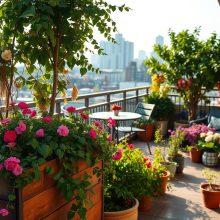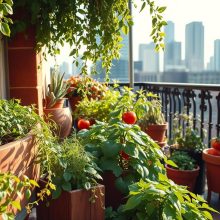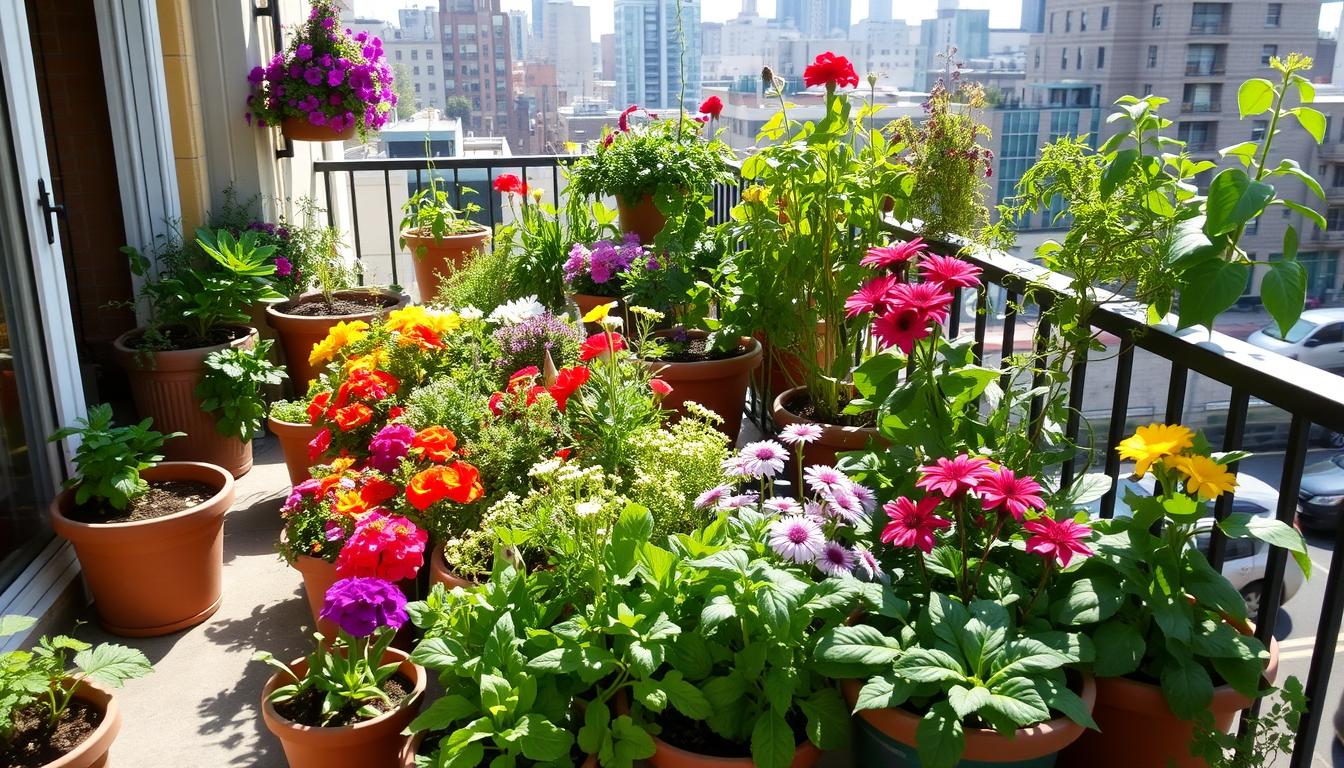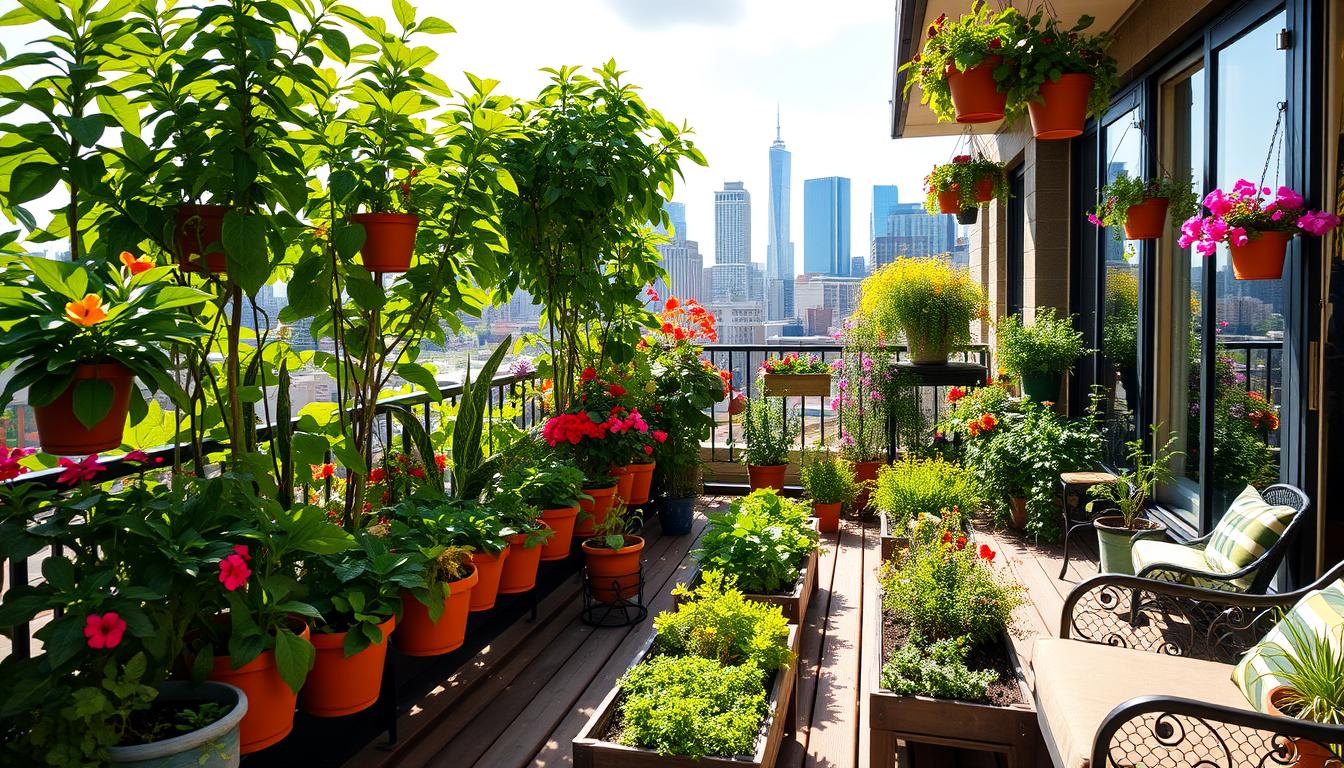Organic Balcony Gardening: A Step-by-Step Guide
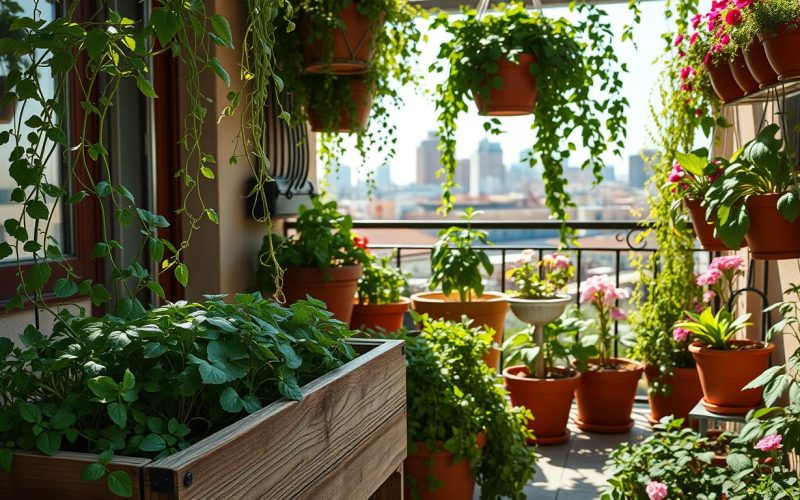
Living in the city doesn’t mean you can’t garden. Organic balcony gardening lets city folks grow their own food and connect with nature, even with little space. It turns small outdoor spots into lively green oases. These oases offer fresh food and a calm escape from city noise.
Urban gardening has grown a lot in recent years. More people enjoy growing organic herbs, veggies, and flowers in small spaces. No matter if you have a small balcony or a tiny terrace, you can create a lush green area with little effort.
This guide is for everyone, from new gardeners to seasoned ones. It covers all you need to know to make a thriving organic balcony garden. You’ll learn how to use space wisely, grow your own food, and make your outdoor space beautiful and productive.
Key Takeaways
- Organic balcony gardening enables fresh food production in small urban spaces
- Sustainable gardening practices can be implemented on balconies of any size
- Growing your own food reduces grocery expenses and increases nutrition
- Balcony gardens provide mental health benefits and connection to nature
- Container gardening offers flexibility for urban residents
Understanding Organic Gardening Principles
Organic balcony gardening is a way to grow plants that’s good for the environment. It focuses on natural methods and health. This approach works with nature, not against it.
What is Organic Gardening?
Organic gardening means growing plants without synthetic chemicals. Gardeners use natural ways to help plants grow. They aim to create a healthy soil environment for strong plants.
- Uses only natural fertilizers and pest control methods
- Promotes biodiversity and soil health
- Minimizes environmental impact
- Supports local ecosystem balance
Benefits of Organic Gardening
Organic gardening has many benefits for both gardeners and the planet. It helps grow healthier food and reduces chemical use. It also supports the environment on a larger scale.
Key Differences from Conventional Gardening
Organic balcony gardening uses natural methods, unlike conventional gardening. The main differences are in soil care, pest control, and feeding plants. Organic gardeners focus on improving soil with compost and natural methods, not synthetic chemicals.
- Natural soil enrichment
- Biological pest management
- Ecosystem-friendly practices
- Reduced chemical dependency
Selecting the Right Containers for Your Balcony
Container gardening turns small balconies into lively green spots. The secret to a successful garden is picking the right containers. These should fit your plants’ needs and your balcony’s size.
Choosing the perfect container is key. It affects your plants’ health, how well they grow, and your balcony’s look.
Types of Containers for Urban Gardens
- Traditional Terra Cotta Pots: Classic and breathable
- Plastic Containers: Lightweight and affordable
- Hanging Baskets: Maximize vertical gardening space
- Fabric Growing Bags: Flexible and portable
- Wooden Planter Boxes: Rustic and sturdy
Material and Size Considerations
Choosing the right materials is important in container gardening. Big containers hold more water and give roots room to grow. Small ones are best for herbs and small veggies.
Drainage Essentials
Drainage is key in small gardens. Containers need holes for water to drain. Add gravel at the bottom to help water flow and protect roots from rot.
- Check for drainage holes before purchasing
- Use pot risers to enhance air circulation
- Select containers with built-in drainage systems
Your container choice is crucial for your balcony garden’s success. Spend time picking the right ones to create a thriving urban garden.
Choosing the Best Soil for Organic Gardening
Starting a successful organic balcony garden begins with the right soil. Quality potting soil is key for a healthy garden. It’s different from regular dirt because it gives plants the nutrients they need.
Understanding soil composition is the first step in sustainable gardening. The right mix of organic soil is vital for plant growth. It ensures your balcony garden gets the nutrients it needs.
Organic Soil Components
- Compost: Provides rich organic matter and nutrients
- Peat moss: Improves soil moisture retention
- Perlite: Enhances drainage and prevents soil compaction
- Vermiculite: Helps retain water and minerals
Soil Quality Indicators
To check your organic balcony gardening soil, look at a few important factors:
- Texture: Loose and crumbly soil is a good sign
- pH Level: Aim for a neutral range between 6.0 and 7.0
- Nutrient Content: A rich, dark color means healthy soil
Tips for Soil Health Maintenance
Keeping your soil healthy is crucial for sustainable gardening. Regular composting, proper watering, and soil testing are key. Refresh your potting mix every year to keep your plants well-nourished.
Essential Tools for Balcony Gardening
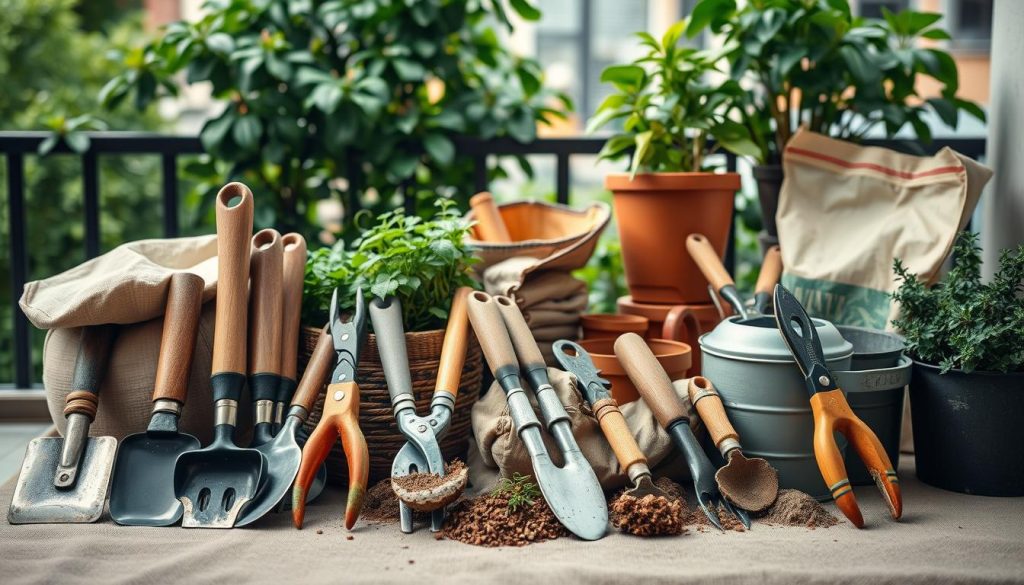
Urban gardening and small-space gardening need special tools. These tools help gardeners make the most of their small balcony areas. The right tools can turn a tiny green space into a lush garden.
Must-Have Gardening Tools
Some tools are key for small-space gardening. Here’s a list of must-haves for balcony gardeners:
- Hand trowel for precise planting
- Pruning shears for plant maintenance
- Compact watering can with a narrow spout
- Gardening gloves for hand protection
- Small hand rake for soil preparation
Eco-Friendly Tool Options
Choosing eco-friendly tools is a great way to garden sustainably. Look for tools made from recycled materials or sustainable wood. Bamboo-handled tools and recycled plastic gardening accessories are good choices for those who care about the environment.
Tool Maintenance Tips
Keeping tools in good shape is important. Clean them after each use, oil metal parts to prevent rust, and store them dry. Sharpening tools like pruners keeps them sharp and reduces damage to plants.
Investing in quality tools for urban gardening makes balcony gardening easy and rewarding.
Picking the Ideal Location on Your Balcony
Starting a successful urban garden begins with finding the right spot on your balcony. Gardening in small spaces needs careful planning. This ensures your plants grow well in their limited space.
Understanding Sunlight Requirements
Sunlight is crucial for any garden. Plants have different light needs that affect their growth. When planning your garden, remember these sunlight tips:
- Herbs need 6-8 hours of direct sunlight
- Leafy greens can handle partial shade
- Flowers need lots of sun
- Use apps to track sunlight
Protecting Plants from Wind
Balcony gardens face wind challenges. Gardening in the city requires ways to protect your plants. This keeps them safe and healthy.
- Use windbreak screens or barriers
- Place tall plants to protect smaller ones
- Choose plants that resist wind
- Secure containers with weights
Maximizing Accessibility and Aesthetics
A good balcony garden is both useful and beautiful. Think about how it looks and works. Arrange your garden to be inviting and easy to manage.
- Place plants you use often within reach
- Use different container heights for layers
- Try vertical gardening to save space
- Choose containers that match in color and style
Choosing Plants for Organic Balcony Gardening
Creating a lively edible balcony garden needs careful plant picking. Urban gardeners can turn small spots into green oases. They do this by picking the right veggies, herbs, and edible plants. It’s important to know each plant’s needs and how well it does in tight spaces.
When planning your balcony garden, pick plants that do well in small spots and pots. Some great options include:
- Cherry tomatoes
- Compact pepper varieties
- Bush beans
- Leafy greens like spinach and lettuce
- Dwarf eggplant cultivars
Herbs and Their Benefits
Herb gardens on balconies are super useful. Herbs like basil, mint, rosemary, and thyme add fresh flavors to food. They also draw good bugs. These small plants grow well in pots and can be picked often to keep them growing.
Vegetables Suitable for Small Spaces
For city gardeners, look for small veggie varieties. Choose dwarf or bush types that grow a lot without needing a lot of room. Using vertical gardening can make the most of your balcony space. This lets you grow more plants in less area.
Decorative Edible Plants
Choose plants that look good and taste great. Plants like colorful Swiss chard, purple basil, and ornamental peppers are pretty and edible. They add beauty to your garden while giving you fresh food for your kitchen.
Planting Techniques for Success
Learning how to plant is key for a thriving container garden. For a successful organic balcony garden, you need to plan carefully. This ensures your plants grow well and produce a lot, even in small spaces.
Proper Planting Depth Matters
Every plant needs a different depth to grow well in containers. Root veggies need deep, while herbs do best in shallow soil. Here’s how to plant each type right:
- Tomatoes: Plant 6-8 inches deep
- Herbs: 4-5 inches of soil depth
- Leafy greens: Shallow 3-4 inch planting
- Root crops: Minimum 10-12 inches of container depth
Strategic Companion Planting
Companion planting makes your balcony garden better by pairing plants that help each other. Choose plants that grow well together and keep pests away:
- Basil protects tomatoes from insects
- Marigolds deter harmful nematodes
- Mint repels various garden pests
Seasonal Planting Strategies
Knowing when to plant is crucial for a successful container garden. Different plants do best at different times. This helps your balcony garden be as productive as possible.
- Spring: Plant cool-season crops like lettuce
- Summer: Grow heat-loving vegetables
- Fall: Focus on root vegetables and hardy greens
- Winter: Use indoor containers or cold-resistant varieties
By using these planting tips, you can turn your balcony into a lively, productive organic garden.
Efficient Watering Practices
Water management is key in sustainable gardening, like in container gardens. Balcony gardens need careful watering to keep plants healthy and growing. Knowing the right watering techniques is crucial for your garden’s success.
Watering Techniques for Balcony Gardens
Container gardening needs precise watering strategies. Each plant has its own moisture needs. It’s important to find a method that works for your plants.
- Bottom watering for consistent moisture absorption
- Drip irrigation systems for controlled hydration
- Self-watering containers for low-maintenance gardens
Optimal Watering Times
Timing is important in sustainable gardening. Water your container garden in the early morning or late evening. These times help prevent water loss and stress on plants.
Detecting Plant Water Needs
Knowing when your plants need water is essential. Look for these signs to know when to water:
- Check soil moisture by inserting a finger one inch deep
- Watch for slight wilting or color changes in leaves
- Use moisture meters for precise tracking
By using these efficient watering practices, you’ll have a thriving, water-saving balcony garden. It will support plant health and save resources.
Fertilizing Organically
Using organic fertilizers is key to a healthy balcony garden. It helps plants grow strong and keeps the garden balanced. Knowing how to fertilize organically can make your garden flourish.
Types of Organic Fertilizers
Choosing the right organic fertilizers is important. Here are some great options:
- Compost: A nutrient-rich soil amendment created from decomposed organic matter
- Worm castings: Nutrient-dense material produced by earthworms
- Liquid seaweed: A powerful organic fertilizer packed with micronutrients
- Bone meal: Excellent for root development and flowering plants
- Fish emulsion: A quick-acting nitrogen-rich fertilizer
How to Apply Fertilizers
When using organic fertilizers, timing and amount matter. For container plants, fertilize every 3-4 weeks in the growing season. Always follow the instructions for liquid fertilizers to avoid harming the roots.
Avoiding Over-Fertilization
Too much fertilizer can harm your plants and the garden. Look out for signs like:
- Yellowing or browning leaf edges
- Stunted growth
- White crust on soil surface
If you’re unsure, start with a small amount. This helps keep your garden healthy and balanced.
Pest and Disease Management
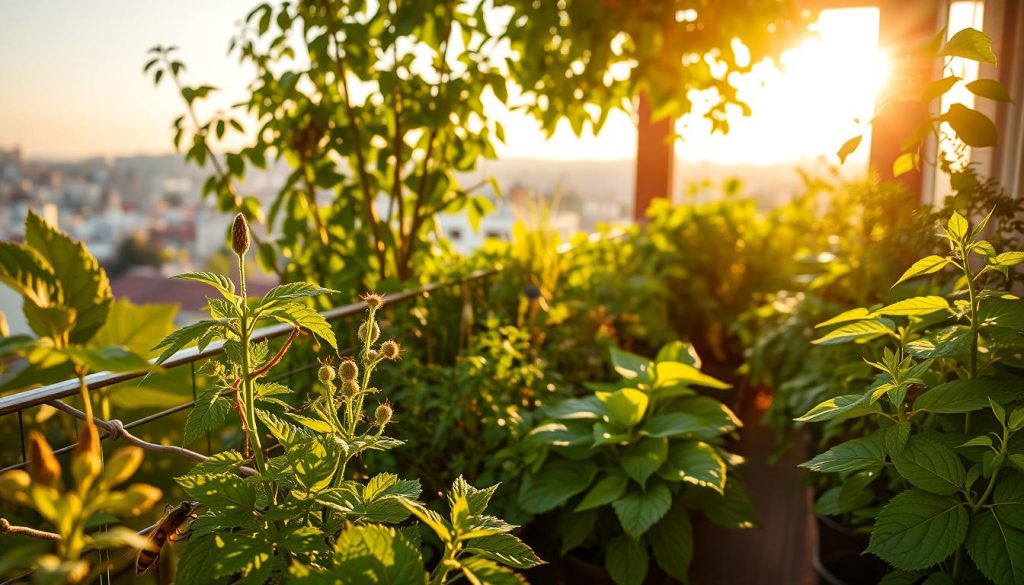
Keeping your balcony garden healthy means fighting pests and diseases. You don’t need harsh chemicals for this. Organic methods can keep your garden thriving without harming the environment.
Common Pests in Balcony Gardens
Small gardens face many pests that can harm plants. Some common ones are:
- Aphids
- Spider mites
- Whiteflies
- Mealybugs
- Fruit flies
Natural Pest Control Methods
Organic pest control has many effective ways to protect your garden. These methods are safe for the environment:
- Create homemade garlic and soap spray
- Use neem oil treatments
- Introduce beneficial insects
- Practice companion planting
- Implement physical barriers
Identifying Plant Diseases
Spotting diseases early is key to stopping them. Look for signs like discolored leaves, spots, wilting, or stunted growth. Regular checks keep your garden healthy and prevent damage.
Using these organic pest control methods helps gardeners protect their plants. It also keeps balcony gardening eco-friendly.
Maximizing Space in Small Areas
Urban gardening turns tiny balconies into green oases with creative techniques. By using smart designs, you can make the most of every inch. This way, balcony gardens can be very productive.
For small-space gardening, you need to think outside the box. The trick is to use space vertically and place plants wisely.
Vertical Gardening Solutions
Vertical gardening is a game-changer for urban gardeners. Here are some space-saving ideas:
- Install hanging planters along balcony walls
- Use tiered shelving units for multiple plant levels
- Implement trellises for climbing vegetables and flowers
- Employ stackable container systems
Utilizing Railings and Wall Space
Balcony railings and walls are great for gardening. You can hang planters, create herb gardens, or use wall-mounted systems. This way, you can make the most of your space.
Companion Planting for Space Efficiency
Companion planting is key for growing more in less space. Pair plants that help each other, like basil with tomatoes or marigolds with vegetables. This strategy boosts your small-space gardening.
Organic Gardening Resources and Communities
Expanding your organic balcony gardening knowledge is easier with the right resources and communities. Urban gardening fans can find many platforms to improve their skills and meet others who share their passion.
Online Learning Platforms
Digital tools have changed how we learn about urban gardening. If you’re starting with organic balcony gardening, there are many online places to learn:
- Gardening websites with detailed tutorials
- YouTube channels focused on urban gardening
- Online forums for small-space gardening
- Webinars and virtual workshops
Local Gardening Networks
Connecting with your community can greatly enhance your gardening journey. Local gardening groups provide support through:
- Neighborhood gardening clubs
- Community garden workshops
- Seasonal gardening events
- Seed exchange programs
Essential Reading for Organic Gardeners
Reading is still key for those into organic balcony gardening. Here are some books worth checking out:
- Urban Gardening Guides
- Organic Cultivation Techniques
- Small-Space Gardening Strategies
- Sustainable Gardening Practices
By using these resources, gardeners can keep improving their skills and stay in touch with the urban gardening community.
Seasonal Maintenance Tips
Sustainable gardening needs careful attention all year. Organic balcony gardening requires smart maintenance that changes with the seasons. This keeps your plants healthy and thriving. Each season brings its own challenges and chances to care for your garden.
In spring, it’s time to refresh your soil and start planting. Add compost to your potting mix, check containers for damage, and plant seeds for herbs and veggies. It’s also good to check drainage, remove debris, and prune plants to encourage new growth.
Summer is about keeping plants cool and moist. Use mulch to keep the soil wet, place containers in the shade when it’s hot, and water in the morning or evening. Regular checks help spot pests and fix any plant problems quickly.
Fall and winter are key for getting your garden ready for the next year. Take out dead plants, clean your containers well, and protect plants from cold. You might bring plants inside or use covers. Good care at the end of the season keeps your garden lively for the next growing season.
